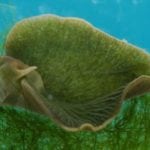 Weird Stuff
Weird Stuff  Weird Stuff
Weird Stuff  Our World
Our World 10 Ways Your Christmas Tree Is More Lit Than You Think
 Movies and TV
Movies and TV The 10 Coolest Stars to Set Sail on The Love Boat
 History
History 10 Things You Didn’t Know About the American National Anthem
 Technology
Technology Top 10 Everyday Tech Buzzwords That Hide a Darker Past
 Humans
Humans 10 Everyday Human Behaviors That Are Actually Survival Instincts
 Animals
Animals 10 Animals That Humiliated and Harmed Historical Leaders
 History
History 10 Most Influential Protests in Modern History
 Creepy
Creepy 10 More Representations of Death from Myth, Legend, and Folktale
 Technology
Technology 10 Scientific Breakthroughs of 2025 That’ll Change Everything
 Weird Stuff
Weird Stuff Ten Bizarre Facts About The Doge Meme
 Our World
Our World 10 Ways Your Christmas Tree Is More Lit Than You Think
 Movies and TV
Movies and TV The 10 Coolest Stars to Set Sail on The Love Boat
Who's Behind Listverse?

Jamie Frater
Head Editor
Jamie founded Listverse due to an insatiable desire to share fascinating, obscure, and bizarre facts. He has been a guest speaker on numerous national radio and television stations and is a five time published author.
More About Us History
History 10 Things You Didn’t Know About the American National Anthem
 Technology
Technology Top 10 Everyday Tech Buzzwords That Hide a Darker Past
 Humans
Humans 10 Everyday Human Behaviors That Are Actually Survival Instincts
 Animals
Animals 10 Animals That Humiliated and Harmed Historical Leaders
 History
History 10 Most Influential Protests in Modern History
 Creepy
Creepy 10 More Representations of Death from Myth, Legend, and Folktale
 Technology
Technology 10 Scientific Breakthroughs of 2025 That’ll Change Everything
10 Birds With Truly Odd Defenses
This is a sequel to one of my first lists, 10 Mammals with odd defenses. Most birds can fly, and flying is already a very effective defense against many predators; however, with over 10,000 species of birds known to date, it was to be expected that some of them broke the mold.
Here’s a small selection of birds with unorthodox defensive mechanisms – if you think there’s another bird deserving of a spot here, don’t forget to mention it in the comments!
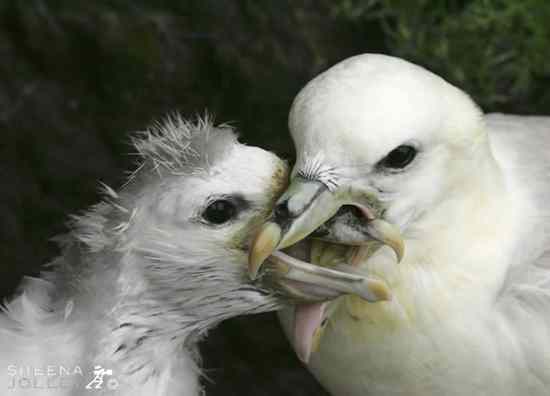
The fulmar is a kind of sea bird, related to the better known albatross. Fulmar comes from the Norse words ful-mar, meaning “foul gull”, and with good reason. These birds are known for their horrible smell; not only the birds reek, but even their eggs do! Fulmar egg shells housed in museum collections still produce their natural, nauseating smell after a hundred years of being stored!
But although the fulmar’s foul smell is a good defense against some predators, such as humans, it is just not enough to deter other predatory birds. This is because birds usually have a poor sense of smell, and they don’t mind their prey being stinky.
Unable to fly or run away from danger, fulmar chicks developed an amazing, if rather disgusting defense mechanism; when threatened, they vomit a bright orange, irritating oil from their stomach, which not only smells bad, but also clings to the predator’s feathers (or fur). This oil makes the feathers of predatory birds become matted, thus losing their insulating properties, and the predator may die of exposure or drown if waterlogged. This makes fulmar chicks not only unappetizing, but actually very dangerous to potential predators.
Interestingly, although adult fulmars can spit oil too, chicks have much better aim, and can shoot repeatedly. They can spit practically since the moment they are born, and some have been reported as spitting even before hatching completely from their egg.
The fulmars themselves have feathers that are “immune” to the oil; this is very important because very young fulmar chicks will not only spit at predators, but at any animal that comes close, including their parents; they only start recognizing their parents (and holding their fire) when they are about three weeks old.
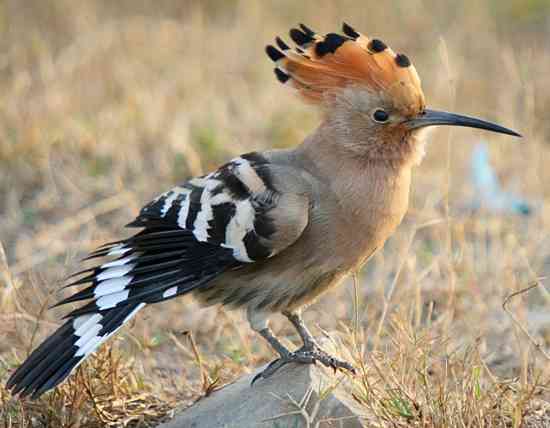
Found in Africa, Europe and Asia, and recently chosen as Israel’s national bird, this relative to kingfishers is noted for its unusual flight (similar to that of a butterfly), its spectacular feather crest and its nasty defensive technique.
Hoopoes have a special gland near the anus, which produces a foul-smelling substance. The bird rubs this substance on its feathers, covering its entire body with a stench similar to that of rotten flesh. Not many predators are interested on having such a foul-smelling bird for dinner.
This substance, however, has a second function; it acts as a parasite repellent, and as an antibacterial agent, protecting the hoopoe from many diseases.
Interestingly, the adult hoopoes produce this secretion only when incubating its eggs and taking care of its young; once the chicks leave the nest, the mother stops producing the noxious substance.
As for baby hoopoes, they have their very own defensive method; when threatened while alone at the nest, they squirt their feces right into the predator’s face. Needless to say, this is a very effective technique to get rid of unwanted visitors.
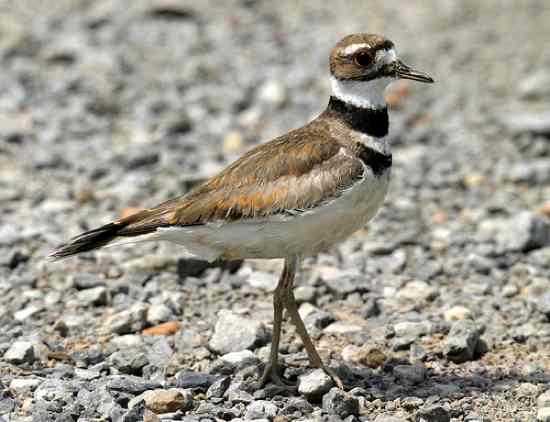
Killdeer are rather noisy birds found mostly in Canada, the US and Mexico; they nest on the ground, so their eggs and chicks are particularly vulnerable to predators.
In order to protect their nest, adult killdeer have developed a clever technique; when a land predator such as a cat, fox or dog approaches the nest, the adult bird moves away from the nest, dragging one of its wings as if it was broken and flapping desperately with the other, and faking a distress call.
Most predators will chase after the seemingly helpless adult, instead of getting closer to the nest; if the predator continues approaching the nest, however, the “injured” adult will crawl closer to the predator until it gains its full attention. When enough distance is established between the nest and the predator, the adult killdeer flies off.
This distraction display is known as the “broken wing act”, and is potentially very dangerous for the adult, but it has saved countless killdeer nests from being discovered and raided by predators.
As for the killdeer chicks, they are known to run away from the nest site while the predator is being distracted by the adult.
Unfortunately, the “broken wing act” works only with predators (naturally attracted to defenseless, injured targets), and is useless against large herbivores such as cows and horses which may end up trampling the nest anyways.
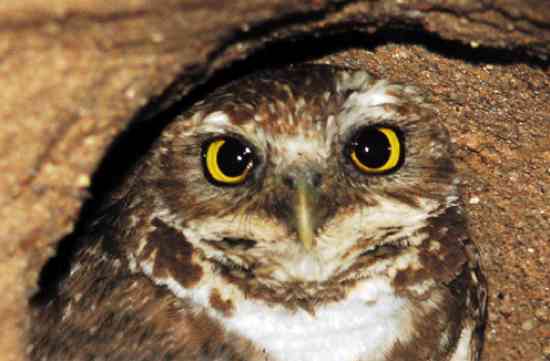
Burrowing owls are found in prairies and deserts from Canada to Patagonia. They nest in burrows, hence their name, and often use the abandoned burrows of other animals; however, if they can’t find any vacant homes, they can also dig a burrow themselves. Burrowing owl chicks are often left alone in the burrow by their parents, which must hunt for themselves and their young. During this time, the chicks are vulnerable to predators such as foxes, coyotes, ferrets and house cats.
In order to keep these enemies away, burrowing owl chicks have developed a rare form of mimicry; whenever they feel threatened (for example, if an animal starts digging at the burrow entrance), the owl chicks produce a hissing call which is very reminiscent of a rattlesnake’s warning sound. Since these highly venomous pit vipers are known to hide in burrows, most predators (including humans!) prefer to flee as soon as they hear the feared rattle.
Adult burrowing owls are known to mimic the rattlesnake’s sound as well when cornered inside their burrow. This amazing defensive mechanism is among the most efficient among birds, but it has a weak point; it is useless against actual rattlesnakes. It is unlikely that these reptiles would be fooled or deterred by the owl’s mimicking call, but not only that; they are actually deaf, and can’t even hear their own rattle, let alone that of an impersonator. As a result, rattlesnakes are among the few animals that dine regularly on burrowing owl chicks.
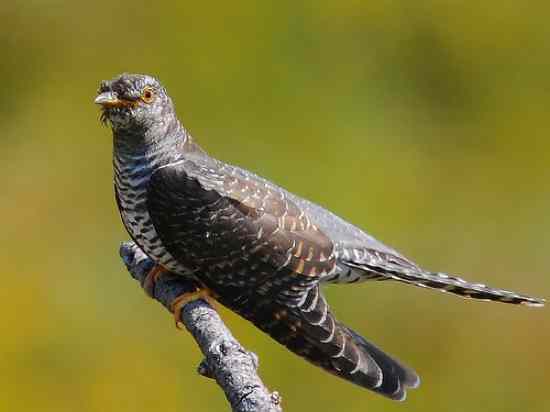
The Eurasian Cuckoo is best known for laying its eggs on the nests of other birds. When the baby cuckoo is born, it destroys the host bird’s eggs or chicks, thus eliminating any competitors and quickly growing to an immense size compared to its foster parents.
But laying eggs on another bird’s nest can be difficult and even dangerous for the Cuckoo, since most small birds are fiercely protective of their nests.
In order to protect itself against potential attacks, the female Cuckoo has developed an appearance very reminiscent of a Sparrow Hawk, a raptor that feeds on smaller birds.
By disguising as a ferocious bird predator, the Cuckoo can scare other birds away from their nests. As long as the false Sparrow Hawk is around, the other birds will not dare return to their nest, and so the Cuckoo can lay her egg without problem and fly away undiscovered and unharmed.
That the Eurasian Cuckoo looks like a Sparrow hawk was noticed by humans long time ago; Roman naturalist Pliny the Elder even believed that Cuckoos could literally transform into hawks. Birds, on the other hand, are seemingly unable to tell a hawk-mimicking cuckoo from a real sparrow hawk, and will panic at the sight of any of them.
The whole hawk-mimicking trick is so effective that there are several other species of Cuckoo that mimic other species of hawk; the South Asian Hawk-Cuckoo, for example, mimics a local kind of sparrow hawk, the Shikra, down to the flight style and even the way it perches!
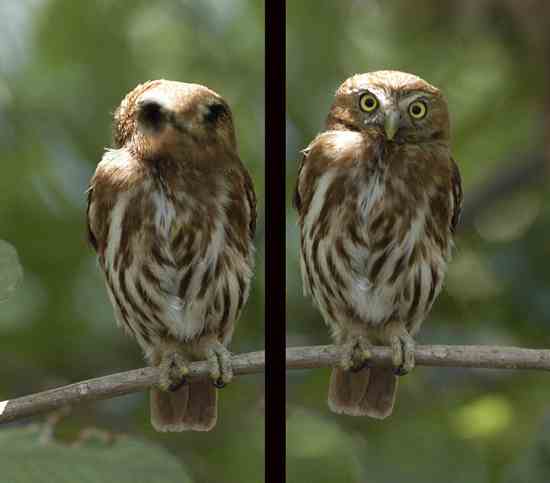
Although owls are usually imagined as going after mice and other rodents, they also hunt many birds, and most small birds are terrified of owls, so much in fact, that when they see an owl during day time (when the owl is less likely to attack by surprise), they will noisily harass it in an attempt to drive it away. This behavior is known as “mobbing”.
Although mobbing is usually just an annoyance for the larger, most powerful owls, it could be potentially very dangerous to smaller species such as the Ferruginous pygmy owl. These fist-sized owls are skilled bird hunters, taking on prey up to twice their own size, and therefore, they are feared by all other small birds in their territory.
In order to protect itself from mobbing, the Ferruginous pygmy owl has two spots on the back of its head which resemble eyes. This is enough to deter most small birds, as they will usually not attack an owl which is looking at their direction. Tricked into believing that the false eyes are the real ones, most birds will either flee in terror, or attack again this time from “behind”, aiming at what they think is the back of the owl’s head.
Of course, in this case they will meet the owl’s real eyes and may even end up as the owl’s meal.
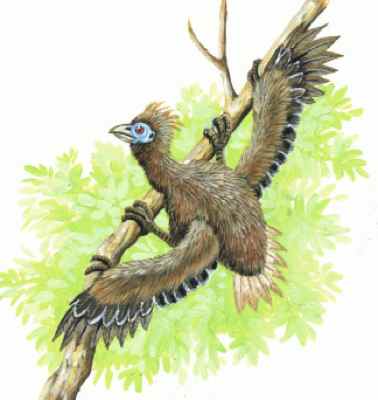
Found in the rainforests of South America, the Hoatzin was once believed to be a “living fossil”, and, even today, its exact relationship to other birds is uncertain. It is unusual in many ways; for example, it feeds on tree leaves, a very strange diet for a bird, and uses bacterial fermentation to digest its food, much like a cow. Because of this, the Hoatzin has a very strong, manure-like odor, hence one of its popular names, “stink bird”. But the Hoatzin’s horrible stench is not the reason why it’s included in this list.
Hoatzins usually build their nests in tree branches hanging over water. When disturbed or threatened by a predator, the Hoatzin chicks leap into the water to escape. They are very good swimmers and divers, and when danger has passed, they can climb up the tree and back into the nest.
In order to do this, Hoatzin chicks have two claws on each wing, reminiscent of those of Archaeopteryx and other feathered, bird-like dinosaurs. Only young Hoatzins have these claws; they disappear as the bird grows older and can escape predators by flying and no longer need to climb. Although the Hoatzin is not the only bird with claws on its wings, it is certainly the most famous, and it has been the object of debate among scientists since its discovery in 1776.
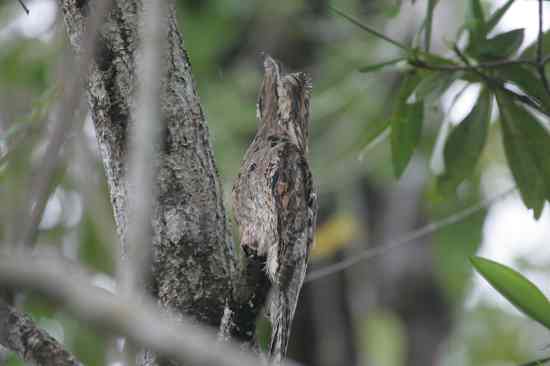
Found mostly in Mexico, Central and South America, these bizarre nocturnal predators are also known as “ghost birds” because of their extraordinary camouflage. The potoo feeds on insects and small flying animals such as bats and small birds, and during the day, it perches on a tree and remains completely motionless, perfectly mimicking a dead or broken-off tree stump. Its feathers resemble tree bark, and its eyelids have a slit that allows the bird to see even when its eyes are closed.
Potoos will usually stay motionless even when approached by another animal (or human), and they only fly away when they feel that they have been discovered. The camouflage is so good, however, that they are almost never discovered, and they barely have any predators. This also makes the potoo extremely difficult to observe during day. At night, it can only be discovered because its eyes reflect light, shining like the eyes of a cat or an owl.
Potoos are not the only birds that mimic tree stumps (Australian frogmouths and some nightjars are also known to do so), but they are certainly the most convincing.
This small owl was little known by the public until recently, when a Japanese TV show featured its extraordinary defensive method. If approached by a small or relatively unaggressive enemy, the masked owl puffs its feathers out and hisses to make itself look bigger and fiercer; this is a common defensive method among owls, even the larger ones, and seems to be enough to scare most enemies away.
However, when confronted with a larger, more powerful enemy, the masked owl doesn’t try to intimidate it, but rather flattens its feathers and squints so that its eyes are almost invisible to the predator. By remaining motionless, and aided by its bark-like feathers, the masked owl does its best to resemble a tree stump or branch, just like the potoo, therefore escaping the larger predator’s attention. Above is a fragment of the famous Japanese TV show featuring the African masked owl (a captive specimen) reacting to two different predators, the Barn Owl and the powerful Verreaux’s Eagle Owl (Africa’s largest owl). Please do watch the clip all the way through – it is truly amazing.
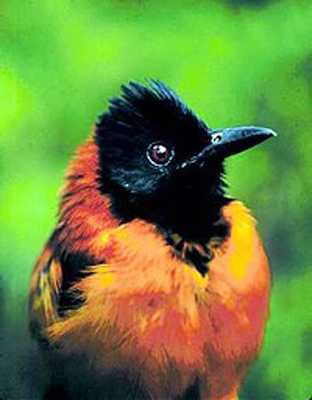
Hooded pitohuis are found in New Guinea, and their defense against predators is as simple as it is amazing; they are poisonous. Hooded pitohuis feed on certain kinds of beetle that contain a powerful neurotoxin alkaloid known as a batrachotoxin (the same poison found in the skin of South American poison dart frogs).
By eating these beetles, the birds become poisonous themselves, concentrating the toxin on their own feathers and skin. They are actually known by locals as “rubbish birds”, as their toxicity makes them impossible to eat unless the skin and feathers are removed and the meat is covered on charcoal and roasted.
Touching a Hooded Pitohui can cause numbness and tingling, as well as skin burns and sneezing (as reported by scientists who have handled the creature), while eating one would probably be much more dangerous; to warn of its toxicity, this bird has a bright, orange and black coloration which allows would-be-predators to recognize it.
It is believed that Hooded pitohuis may rub the toxin on their eggs and chicks to protect them from predators. And, as if this wasn’t amazing enough, we know now that the Hooded Pitohui is not the only poisonous bird; others, such as the Variable Pitohui and the Blue Caped Ifrita (also found in New Guinea) have also been confirmed as poisonous, and it seems possible that there are many others yet to be discovered, even among already known species.


